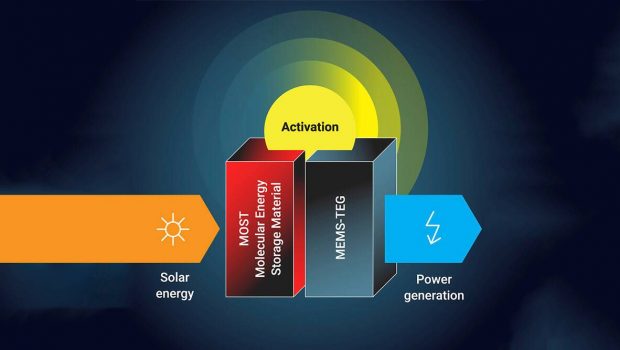Researchers develop solar energy storage and transport technology without need for solar panels
Researchers at the Chalmers University in Sweden and the Shanghai Jiao Tong University have come up with a technique to harvest, store and transport solar energy and then derive electricity from it. All of this will be possible without the use of conventional photovoltaic cells or batteries.
The researchers have documented this technology in an article titled, “Storing energy with molecular photoisomers,” published in the journal Joule in December 2021. With their MOST (Molecular Solar Thermal Energy Storage Systems) technology, the researchers successfully devised a method to store solar energy as chemical energy within a special kind of molecule, for up to 18 years.
This molecule changes its chemical properties when it comes in contact with sunlight and stores some of that energy within new chemical bonds. This chemical energy can then be released in the form of thermal energy with the addition of a catalyst if and when required. The device can be used to store solar energy when sunlight is available and provide thermal energy when it is not.
But the storage of energy using MOST technology initially presented another problem: this energy can then only be converted into thermal energy using a catalyst.
While thermal energy is very useful in many applications, including heating, it is nowhere near as versatile as electrical energy which can be used to power a large variety of devices and applications. Also, existing technologies that can convert thermal energy to electricity don’t really have the efficiency to work at the scale of MOST systems.
“The purpose of the project is to store solar energy into chemical energy inside organic molecules. And later when we want to use the stored solar energy, it is released as heat. And the next step was to convert this stored energy into electricity,” Zhihang Wang, a postdoc at Chalmers University in Sweden and lead author of the paper, told indianexpress.com.
In order to solve this part of the problem, Wang and his fellow researchers developed a new ultrathin chip-based device that can convert the thermal energy released by the MOST system into electrical energy.
For this, the chemical molecules with stored energy were created in a lab in Chalmers University in Sweden and shipped to researchers at the Shanghai Jiao Tong University. The chip-based device was used to convert the released thermal energy into electrical energy, albeit in the scale of nanowatts. This new technology has been documented in a separate paper titled, “Chip-scale solar thermal electrical power generation,” published in the journal Cell Reports Physical Science.
The researchers envision many uses for the combined system of MOST and the new chip-scale electricity generation solution.
“We can, for example, generate solar energy in places with a lot of sunlight and have it shipped to regions which do not have sunlight. Earlier, we came up with technology that could release thermal energy that could be used for different purposes, like domestic heating. But now, this technology has the potential to produce electricity from that,” explained Wang.
This combined system could also be useful in locations close to either the North pole or the South pole, which get continuous months of sunlight followed by months of darkness. In such situations, MOST technology could be used to store solar energy when there is sunlight, and release it during the months when there isn’t.
While the technology is still in its infancy, it holds a lot of promise in a variety of applications. For example, Wang didn’t rule out the possibility of using the chip-scale thermal electricity harvesting device in mobile devices, where it can repurpose the heat from the device’s internals and convert it back into electricity. However, such an application lies outside the research interests of the team.








Gloss